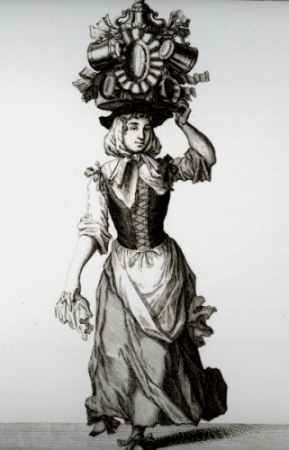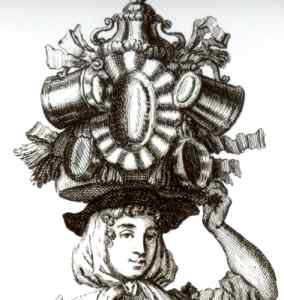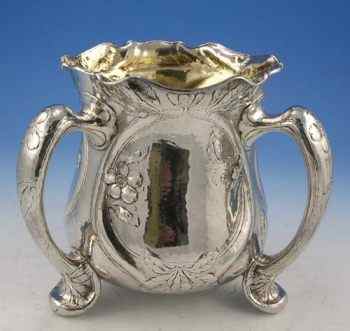Bernard Jouret
receives these replies about his candlesticks
(see September Newsletter)
Hugo Keymeulen writes:
... these candlesticks are from Belgium from the
city of Mons (Bergen), date letter Crowned 79 stands for
the year 1779.
The hallmark crowned AE stands for the initials AE =
Albert, Elisabeth, since 1610 until 1790
Crowned Tower hallmark (tour or chateau) several models
over the years since 1450, this model is from around
1780
The silversmith is unreadable,
Hugo
Raoul Verbist writes:
... Here an answer on Bernard Jouret’s question
on origin of his beautiful candlesticks.
Your candlesticks were made in Mons (Belgium) Year 1779
Mark 1: for the year 79 under crown
Mark 2 and 3: marks for the city MONS (Belgium), letters
AE for Albert and Isabelle and tower
Mark 4 : mark for silversmith not possible to be
identified
I suggest to consult ASCAS member
article n°1 for more explanation on marks 2 and 3,
Town mark of town MONS
Raoul Verbist
Ginter Christophe writes:
... regarding B. Jouret's question, the marks
were stamped in Mons (Belgium), 1779.
I guess the fourth mark (right) is the maker's one.
Unfortunately I cannot identify the content of the mark.
Best regards.
Ginter Christophe
Janjaap Luijt writes:
... about Bernard Jouret question :
from left to right:
date letter: 1779
town marks: Mons, Belgium
makers-mark: LF ?
The makers-mark is not mentioned in the reference books
on Belgium silver.
Best regards,
Janjaap Luijt
Ludo D’Haese writes:
... Vos bougeoirs sont Belges de la ville de Mons de l’année 1779.
La photo du poinçon d’orfèvre est trop flou pour l’identifier.
Si possible envoyer une meilleure photo.
Bien à vous
Ludo D'Haese
Ross
Macrae receives this reply about the marks of
his spoon
(see September Newsletter)
Hugo Keymeulen writes:
... 1 Lyre T, is the Belgian silver mark
for 1831-1868 for fineness 934 1/36
worn Minerva's head, should have a letter in the
helmet indicating the town:
A-Brussel
B Antwerpen
C Gent
D Liege
E Mons
G Brugge
H Kortrijk
I Leuven
K Tournai
L Namur
M Hasselt
N Arlon
O Roermond
The maker is J.B.Huysman D'Herdt from Gent, all
his work is covering the period 1831-1869
The identification should be confirmed with the
letter C in the helmet
Greetings
Hugo
Ludo D'Haese writes:
... La Cuillère est Belge pour la période de 1831 à 1er Juillet 1868.
La lyre est le poinçon de titre que est le premier titre (.950)
La tête de minerve est le bureau de garantie. Dans le casque il y a une lettre ( dans votre cas une
C qui veut dire la ville de Gand)
Les lettres HD avec aux milieu une bouteille est le poinçon d’orfèvre de ' Huysman J.B. &
D’ Herdt '.
Votre cuillère de première titre a donc été faite par la firme ' Huysman J.B. & D’Herdt ' dans
la ville de Gand entre 1831 et 1er Juillet 1868.
Bien à vous
Ludo D'Haese
Mario Galasso
receives this reply about the marks of
his Scottish caster
(see September Newsletter)
Robert Massart writes:
... In your latest newsletter
Mario Galasso asks to define the maker
of the caster he bought.
The caster was made by James Weir I of
Glasgow, who was described as a jeweller.
Kind regards,
Robert
"A PAGE per
MONTH"
In this column
we present a page obtained from makers'
brochures, books, auction catalogs,
advertising or whatever other printed
paper related to silver, which may be of
interest for ASCAS members.
The images will be published at a "low
resolution" level and for private and
personal use only
This month ASCAS
presents the engraving The Merry Milk
Maid from a design of Marcellus
Laroon the Elder (c. 1688) included in
the series The Cryes of the City of
London

|

A custom related to silver
that continued into the 19th
century was for milkmaids to
dress in their best clothes on
May Day and dance for their
customers. They carried a
headdress adorned with silver
tankards, plates, and other
silver objects to add to their
allure.
|
"A WORD per
MONTH"
In this column
we presents an abstract from a page of
the "What is? Silver Dictionary"
courtesy of


|
MARTELE (GORHAM)
Martelé was produced at the
end of the 19th/beginning 20th
century in Gorham's Providence's
plant (Rhode Island) by masters
silversmiths under the direction
of William C. Codman.
Each artisan handcrafted an
entire piece as ancient
silversmiths once did.
Production included bowls,
tankards, vases, chambersticks,
claret sets, letter openers,
candlesticks, porringers, mugs,
cigar lighters, inkwells,
centerpieces, tea and coffee
sets....
more
|
"A BOOK ON
MY SHELF"
In this column
we present books, new or ancient,
dealing with silver in all its aspects (history,
marks, oddities...). This isn't a "book
review" but only a fair presentation of
some useful "tools" that anyone may have
in the shelf of his bookcase.
ASCAS members are invited to contribute
to this column
(click to enlarge images)
The "book on the shelf" of this month
is presented by Karin Sixl-Daniell:
ONE HUNDRED YEARS OF ENGLISH SILVER
1660-1760
Closing our
OCTOBER 2008 edition of ASCAS Newsletter
I hope you have appreciated its content.
Your comments, suggestions and advice
will be of great help.
My
thanks to Pierre-Emmanuel Augé, Joyce
Colpetzer, Paola Continella, Ludo D'Haese, Jayne Dye,
Ginter Christophe, Tamera Guerin, Magnus
Hedberg, Hugo Keymeulen, Janjaap Luijt,
Robert Massart, Karin Sixl-Daniell,
Prof. David N. Nikogosyan, Sue Tiffin,
Bella Tucci, Raoul Verbist, JoAnne
Wilkinson, for their invaluable
contributions.
Giorgio Busetto
Secretary
DISCLAIMER
AND PRIVACY POLICY
ASCAS is a community of
people having a common interest
in antique silver.
It is a non-profit association
without commercial links.
Membership is open to whomever
has a true interest in this
subject matter.
ASCAS has no real property and
no fees are requested nor
accepted from members.
ASCAS keeps in touch with its
members only through periodical
newsletters, e-mails and
web-site updating and ignores
and is not responsible for any
other activity pursued by its
members.
Likewise, ASCAS is not
responsible for opinions,
evaluation and images displayed,
and in any form published or
supplied for publication, by its
members who, in any case,
maintain the property of their
works and assure the respect of
national and international
legislation about Intellectual
Property.
ASCAS does not have the full
addresses of its members (only
town, country and e-mail address
are requested for membership).
ASCAS handles and protects with
care its members e-mail
addresses, will not disclose the
addresses to third parties, will
use this information only to
reply to requests received from
members and for communications
strictly related to its activity.
These rules are expressly
accepted by submitting the
membership request.
|
|
|
|
|
|
 newsletter # 53 - OCTOBER 2008
newsletter # 53 - OCTOBER 2008